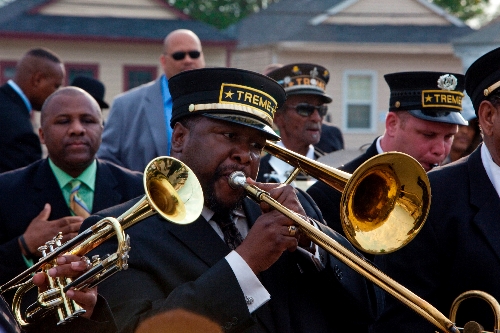HBO’s New Orleans-set ‘Treme’ filled with music, soul

First things first: It’s pronounced truh-MAY. As in the culturally rich New Orleans neighborhood at the heart of “The Wire” creator David Simon’s stirring new “Treme” (10 p.m. today, HBO).
It’s an area so beloved by music historians that resident jazz geek Davis McAlary, brought to life by the great Steve Zahn’s high-strung hipsterism, tries to rid it of other white folks. “This is the Tremé, dude,” he lectures his gentrifying new neighbors. “The most musically important black neighborhood in America.”
And it’s an ideal setting for Simon — in his fourth project for HBO after “The Corner,” “Generation Kill” and the legendary “The Wire” — to continue looking at what it takes to survive in neglected communities on the brink of collapse.
“Treme” opens three months after Hurricane Katrina, with most New Orleanians still dispersed throughout the country. But those who remain are brought together through the magic of one of the city’s famed second lines — in this case, a ragtag blend of brass bands, music lovers and curious onlookers parading through the devastation, dancing atop ruined cars and making the whole thing seem like the most joyful celebration you could imagine.
And it serves as a grand introduction to TV’s most musical series this side of “Glee.”
No one walks on “Treme.” Characters bounce, bop, swing, sway, glide, slide, strut and stroll. But walking? That’s for the rest of the country. In almost every frame, Tremé residents prove Gloria Estefan was right when she warned all those years ago that, sooner or later, the rhythm is gonna get you.
Honestly, there’s more soul in 30 seconds of “Treme” than in anything else you’re likely to see all year. And while I have no idea whether this is how New Orleans really is — I’ve been only once, I was 11, and it scared the hell out of me — it’s the way I’ve always hoped it is.
If there’s anything that ties “Treme” together other than music, though, it’s a sense of perseverance amid the day-to-day struggles — looting, overzealous police, the lack of proper housing and utilities, stray corpses turning up — in the aftermath of one of the world’s great disasters.
Trombonist Antoine Batiste (“Wire” alum Wendell Pierce) hustles to make ends meet by playing what few, far-flung gigs remain, whether they be legit jazz showcases, funeral processions or a spot in the house band at a Bourbon Street nudie bar.
Mardi Gras Indian chief Albert Lambreaux (Clarke Peters, who worked with Simon on both “The Wire” and “The Corner”) sets out to uphold the proud tradition of Carnival through the sheer force of his inexhaustible will.
Bar owner LaDonna Batiste-Williams (“The Corner” veteran Khandi Alexander) and chef Janette Desautel (“Deadwood’s” Kim Dickens) fight to keep their establishments open and up to code.
And Tulane English professor Creighton Bernette (John Goodman, because he seems to come attached to any film permit for shooting in New Orleans) spends his days railing against government incompetence and defending his beloved city to reporters who just can’t seem to understand the need to rebuild it.
But the music is never far away. It’s “Treme’s” leading man, its sexy young ingenue, its aging diva, its wacky neighbor and most of its plot.
Most importantly, it enables Simon to practice a sort of jukebox anthropology, letting viewers learn about a society through its music — both the live performances and a magnificent, wordless, three-minute montage set to Louis Prima’s “Buona Sera.”
As such, “Treme’s” guest stars serve as a primer to the New Orleans music scene. Allen Toussaint. Dr. John. Kermit Ruffins. Trombone Shorty. Galactic. Coco Robicheaux even turns up to add a little ju-ju and gris-gris to the proceedings.
The series might play at times like a soundtrack in search of a story. But when the soundtrack’s this good, you probably won’t even care.
Just give “Treme” an hour — or, in the case of tonight’s premiere, 80 minutes — and the rhythm is bound to get you, too.
Christopher Lawrence’s Life on the Couch column appears on Sundays. E-mail him at clawrence@review journal.com.